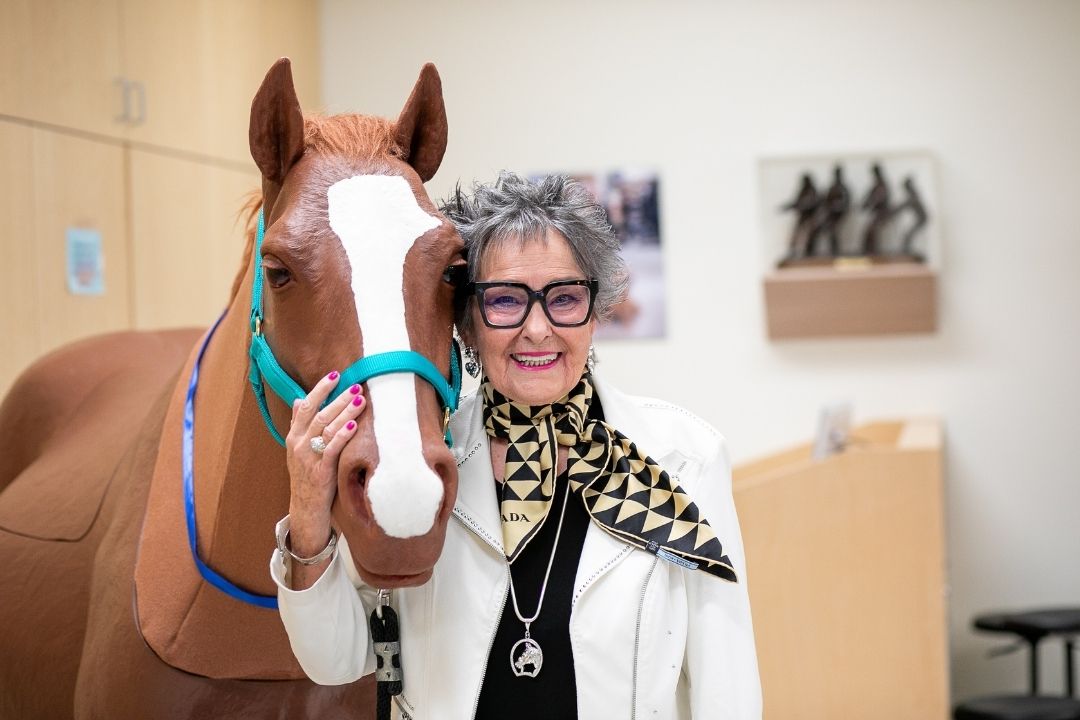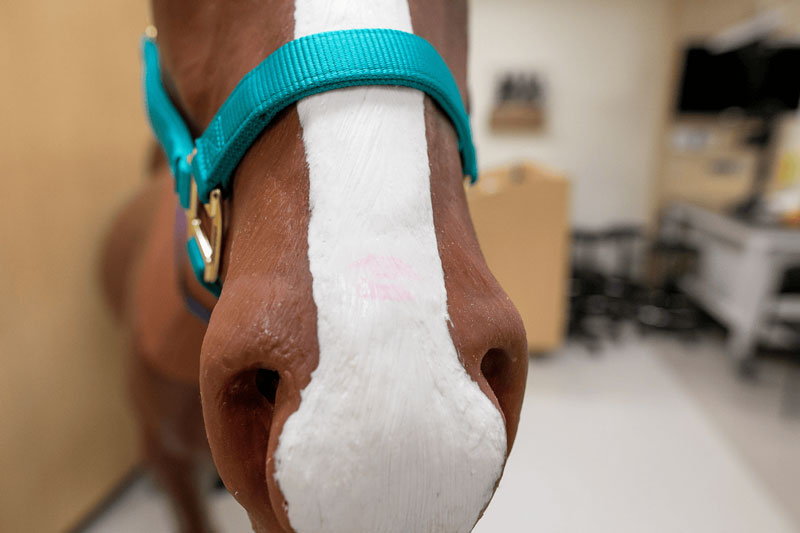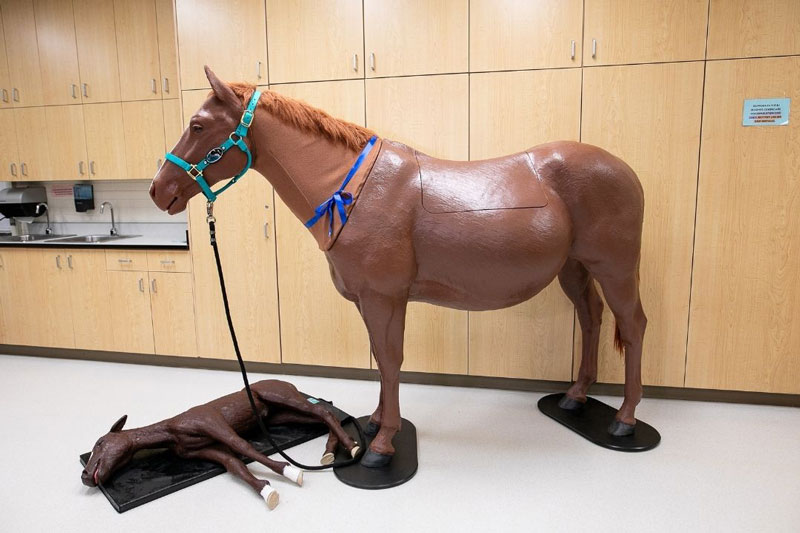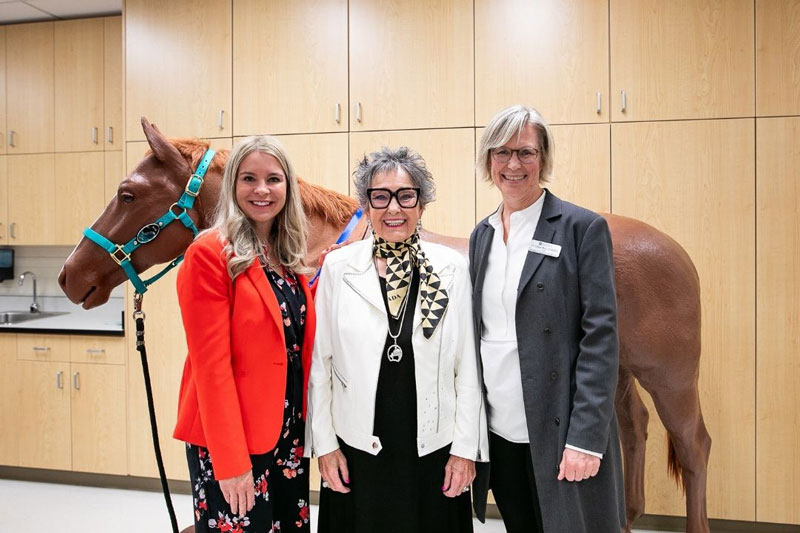
Bubbles and Biscuit: equine foaling models advance training at WCVM
When Dr. June Donaldson (MBA, EdD) saw Bubbles the mare model for the first time, she did what anyone might do when reuniting with a beloved childhood horse: she kissed it on the nose.
By Rigel Smith“I just walked right up and kissed her,” she says with a laugh. “It was just so touching.”
The horse, of course, wasn’t real. But to Donaldson, the life-sized equine model constructed of fibreglass and synthetic rubber felt remarkably familiar.

Built by Calgary-based Veterinary Simulator Industries (VSI), the horse is modelled after her grandparents’ draft horse, Bubbles, who lived on their farm in the County of Leduc, Alta. The mare’s broad back, gentle eyes and striking blaze — now forever adorned by a lipstick-kiss imprint — looks just like Donaldson’s adored childhood friend.
Donaldson, now a best-selling author, describes Bubbles as “the main attraction” of visits to the farm. Steady and gentle, Bubbles was the kind of horse you could crawl under, paint toenails on, or pile five kids onto for a ride.
“My brother could stand on her back with a Superman cape while she galloped down the laneway,” Donaldson recalls. “The farm was never the same after she was gone.”
The mare model came paired with a life-sized, 34-kilogram foal named Biscuit in honour of Seabiscuit, an American thoroughbred racing superstar in the late 1930s. Donaldson became deeply involved in preserving Seabiscuit’s legacy, particularly that of his Canadian-born jockey, Red Pollard. Over the years, she has helped to recognize the historic accomplishments of both horse and rider in Canada and the United States with the Seabiscuit Heritage Foundation’s support.

The idea of donating the models to the veterinary college first took root during a tour of the WCVM’s BJ Hughes Centre for Clinical Learning in October 2024. Donaldson and her partner, Rob, were visiting the space when a passing comment from the centre’s manager, Carolyn Cartwright, stuck with them.
“She said to us, ‘What we really could use is a mare and foal,’” recalls Donaldson. As Cartwright explained to the couple, the college’s veterinary students could use the models to enhance their clinical skills in foaling.
On the drive back to their home in Calgary, the idea rolled around in Donaldson’s mind. With a little encouragement from Rob, she decided to fund the creation of the models.
“It just felt right,” she says. “You walk into that space [the BJ Hughes Centre] and you think, ‘This is where learning happens. This is where people are becoming who they’re meant to be.’ I wanted to support that.”
Less than three months later, a surprise Christmas gift for the BJ Hughes Centre team arrived at the doors of the WCVM in Saskatoon. Carefully packed inside a large wooden box stood the 15-hand equine birthing simulator, with her foal tucked neatly underneath.

Thanks to Donaldson’s generous donation, the models now give WCVM veterinary students the rare chance to practise normal and abnormal foaling scenarios in a safe, hands-on environment.
“Foaling is a critical time for the mare and the foal, and things can happen quickly. It’s not necessarily best for the mare to have a group of students present, and often there isn’t time to teach when it’s happening live,” says Dr. Gillian Muir (DVM'88, PhD), dean of the WCVM.
“Assisting with a difficult foaling can involve working at the full length of your arms [inside the mare], trying to make subtle manipulations in a very tight area. That’s the kind of skill you can’t be practising for the first time when a real animal is in trouble.”
Veterinary students can also use Bubbles to learn how to insert a tube in a horse’s esophagus and stomach — a technique that veterinarians often use in equine colic cases.
The mare and foal now reside in the BJ Hughes Centre as welcome additions to the college’s already extensive collection of hands-on training models. Veterinary students — along with clinical interns and residents — take part in over 700 clinical skills labs that are held at the simulation centre each year.
Muir, a WCVM alumna herself, says she’s often struck by the benefit that practising on simulation models has.
“Simulation is a game changer,” says Muir. “When we bring alumni here who were students around the same time as I was or earlier… they are just so impressed what we can offer our students now, and we all wish that this approach was around when we were in vet school.”
In addition to the simulator, Donaldson donated two framed prints that will be on display at the college. One is a painting of herself, her brother and his friend, standing beside their beloved Bubbles on the farm. The other is a rare photo of Seabiscuit, a favourite of Seabiscuit’s owners, which Donaldson received from the Seabiscuit Heritage Foundation.
For Donaldson, giving the equine foaling simulator to the WCVM isn’t just about honouring her past — it’s about preparing future veterinarians for those high-stakes moments when animals’ lives depend on their clinical knowledge and skills.
“This magnificent facility offers both the book smarts and the hands-on skill,” she says. “And when you put those together, you end up with people who are confident, who are self-assured, and who can hit the floor running to get the job done — and that's what needs to happen in the area of safe foaling.”
Article originally published at https://wcvmtoday.usask.ca


